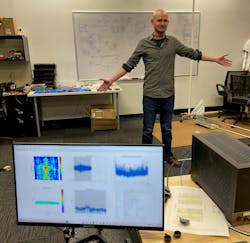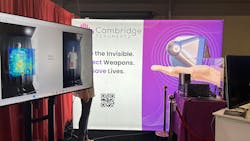Terahertz Imaging Poised to Shake Up Weapons Detection
The Skinny
- Cambridge Terahertz, a startup emerging from MIT research, is debuting a compact, chip-based terahertz radar system for detecting both metallic and non-metallic concealed weapons using safe, high-resolution imaging technology.
- The system leverages terahertz waves—which can see through clothing but not penetrate the human body—to provide real-time 3D imaging, enabling use in schools, hospitals, and corporate buildings without intrusive airport-style screening.
- Founder Nathan Monroe, inspired by a personal tragedy, is focused on transparency about limitations and responsible deployment, with plans for AI integration, pilot programs in 2025, and a full product launch by year’s end.
In an industry recently marred by some overpromises when it comes to technological capabilities, a new player is emerging in the weapons detection field with a revolutionary technology approach. Cambridge Terahertz, a company born from MIT research, is pioneering the use of terahertz radar imaging technology to address the security challenge in a novel way.
The practical use of Terahertz (THz) technology has long been considered a futuristic concept yet to be harnessed in real-world applications; however, Cambridge Terahertz founder and CEO Nathan Monroe, PhD, an MIT-trained electrical engineer with extensive experience in chip design, is looking to change the narrative.
After nearly three years of extensive development in its Silicon Valley-based labs, Monroe and Cambridge Terahertz will emerge from stealth at ISC West 2025, showcasing an early demo of their THz-based weapons detection system.
“We are one of the first companies in the world to use terahertz technology, so we kind of have to blaze the trail here,” Monroe explains. “What we show at ISC West will be a demo of our sensor system for concealed weapons detection applications. Our roadmap includes a product trials in Q3 and pilots by the end of this year, but we are still working on the software and the AI.”
Interested integrators and security technologists who check out the demo at ISC West (booth 33106), will see what amounts to the ideal end-game for weapons detection systems – a safe technology that is compact, easy to deploy at chokepoints, and network-centric to enable fast and accurate screening.
From Tragedy Comes Innovation
The roots of his mission run deep for Monroe. He grew up in northern Florida, and his high school, a private school in Jacksonville, experienced a tragic shooting in 2012. “Some of the victims included a teacher I was very close with,” he recalls. “We try not to dwell on this tragedy, but what my community went through was terrible.”
Monroe’s devastating loss created a passion within him for preventing another such tragedy. That led him to MIT, where he spent over a decade earning three degrees in electrical engineering, including a PhD in chip design. He was a key member of a team at Microsoft that innovated the Xbox Kinect’s LiDAR system, but his true calling came when he discovered terahertz technology at MIT.
While the company is based in Silicon Valley, its name harkens back to Monroe’s roots at MIT;..
“We spun out the company in the middle of 2022 based on my PhD work, and we've been off to the races trying to build things that help people,” Monroe says. “Given my high school experience, we just want to detect weapons to save lives.”
How Terahertz Wave Technology Works
Terahertz waves occupy a unique space in the electromagnetic spectrum between microwaves and infrared light. This frequency range, which spans from 0.1 to 10 THz, has properties that make it ideal for security imaging. Unlike X-rays, which can be harmful to biological tissue, terahertz waves are non-ionizing and completely safe for human exposure.
“Terahertz is the big brother of millimeter wave,” Monroe explains. “We’re still using radio frequencies, but they are much higher frequencies. Millimeter wave scanners operate at around 30 to 80 GHz, whereas our solution starts at 300 GHz – or 0.3 THz. That allows us to achieve an unprecedented level of resolution in imaging while shrinking the product size to fit in the palm of your hand.”
THz waves can penetrate common materials like clothing, packaging, and plastics while being absorbed by metals and water, so they can be used to detect concealed objects without physical contact. Cambridge Terahertz’s imaging technology leverages these properties by using advanced phased array radar techniques to create high-resolution, real-time 3D images of objects hidden beneath clothing or inside packages.
This means that security personnel can see metallic weapons as well as non-metallic threats such as plastic explosives, drugs, and concealed electronics. It is one of many futuristic applications that researchers have attempted with the technology.
“Terahertz technology today feels much like computing did in the 1960s,” Monroe says. “Everyone in the field sees its potential.”
Other lab applications and research include package inspection, medical imaging, and ultra-fast communication systems; however, the majority of these lab-based demos required a room full of expensive technology, which often limited THz technology to military applications.
Monroe says the breakthrough lies in Cambridge Terahertz’s ability to miniaturize this technology onto a chip, allowing for deployment in everyday environments.
“Terahertz has been on this collision course with Moore's Law, and what used to take up an entire room can now fit on a chip – and that’s a big deal,” Monroe says. “When you can put something on a chip, it suddenly becomes inexpensive and scalable. The sensor system is radically smaller than anything that has come before. It allows us to take high-resolution imagery in a device that fits in your pocket.”
Applying Terahertz to Security Applications
The primary focus of Cambridge Terahertz is concealed weapons detection. Unlike traditional metal detectors, which rely on detecting metal objects, THz imaging provides a three-dimensional view of objects hidden beneath clothing.
“Because we use THz radio waves instead of light, we can see through anything that’s not conductive,” Monroe says, adding that the system can detect both metallic and non-metallic objects – firearms, knives, plastic explosives, drugs, cash, and even USB flash drives, which pose a security threat to data centers.
“Schools are worried about vapes, prisons are worried about fentanyl, and border security is concerned about smuggling, so the ability to detect both metallic and non-metallic threats is a game-changer,” Monroe explains.
Physics gives THz technology unique advantages, including the potential for high-performance and extremely small systems. Having compact, non-intrusive systems enables proactive concealed weapons detection applications in schools, hospitals, corporate campuses, and other areas needing security screening.
“This is a network-centric system – it has Ethernet and Wi-Fi, and it securely interacts with existing video management systems,” Monroe says. “It can be placed over doorways and entrance systems.”
Applying THz in this way is something that Monroe considers a true technology breakthrough; however, he is careful not to overpromise – in fact, he intends to explicitly disclose the technology’s limitations.
“We've all seen companies that overstate their abilities and lose trust of the community, so we're very open about the system’s limitations,” Monroe says. “This is not perfect – there are places it can be defeated and places where it fails, just like any other system.”
One of those limitations, Monroe says, is the fact that THz waves cannot penetrate the human body – so, if a person is standing directly behind another person with the detector in front, it will not “see” the second person. That also means that it takes multiple units to achieve a complete scan – one in front and one in back.
Monroe promises that Cambridge Terahertz is going to be very deliberate about use-cases to minimize potential shortcomings of the technology.
“We are starting with enterprise entrance control systems, which capture a pretty wide range including hospitals, government buildings like courthouses, corporate offices, and schools – places that already have security today,” Monroe says. “This is a very deliberate choice that allows us to play to our strengths, and as the technology develops, we will expand the use-cases. But we are going to say no to customers who want to use this in a place we don't think it will work.”
In the end, Monroe’s goal is to integrate security into everyday environments. “People wouldn’t show up to work if they had to go through airport-style security every day,” Monroe notes. “Our goal is to make security blend into the background. We see a massive opportunity schools, hospitals, government buildings, and of course, the private sector.”
Addressing the Challenges of New Technology
With any new technology, skepticism is inevitable, and just as it was when millimeter wave scanners were introduced at airports, there are safety concerns.
“We went to the FCC and worked with them on our technology and how we use terahertz,” Monroe says. “It was a very long and expensive process, but at the end of it, we became one of a small handful of companies in the world that were granted an FCC license to operate at terahertz. That included an extensive human safety and radiation hazard analysis.”
Another challenge is ensuring the system is both fast and accurate – and eventually not 100% reliant on human monitoring.
“We’re working on AI integration to automate detection,” Monroe says. “In the heart of Silicon Valley, AI is basically in the water – so, obviously we're thinking about it. If you don't have AI, you have a human looking at a screen, which is expensive. Also, there's a saying that an alarm that's always going off is never going off – meaning humans are notoriously bad at responding to very low-probability events like a weapon detection, especially when it's surrounded by potential false positives.”
Monroe says other long-term goals include making the technology portable, such as a handheld system; however, for now, Monroe and his team are laser-focused on bringing the first version of the system to market, and ISC West is the perfect unveiling platform.
“It is not a complete product yet, but we'll be demonstrating concealed weapons detection using a mannequin,” Monroe says. “We have about 80 customers signed up right now and about a dozen LOIs for early trials and pilots in the summer timeframe. We are looking at a full product launch by the end of this year, so we are very excited.”
About the Author
Paul Rothman
Editor-in-Chief/Security Business
Paul Rothman is Editor-in-Chief of Security Business magazine. Email him your comments and questions at [email protected]. Access the current issue, full archives and apply for a free subscription at www.securitybusinessmag.com.




